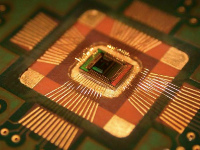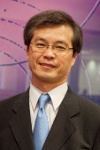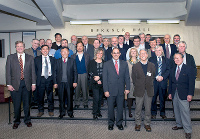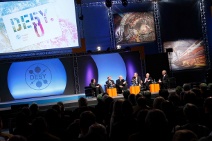AIDA trumpets
This month's Research Director's Report was written by François Richard, co–chair of the Worldwide Study, regional detector contact for Europe

Successful bonding in a test Printed Circuit Board, for an electromagnetic calorimenter developed by the CALICE (Calorimeter for Linear Collider Experiment) collaboration, thanks to the EUDET programme. Image: EUDET. |
AIDA is an acronym for the contract recently approved by European Union in favour of detector R&D for particle physics. It means Advanced European Infrastructures for Detectors at Accelerators. I suspect that this acronym, inspired by the famous opera from Verdi, can be viewed as reflecting the large number of participants involved in this ambitious Opera(tion).
Read more...
-- François Richard
Research Director's Report Archive |
|
 |
 |
|
|
 |
Japanese scientist community identified ILC in their "Master Plan"

Hiroaki Aihara who acts as a coordinator for the Japanese particle physics community during the master plan selection process. Image: KEK |
On 17 March, the Science Council of Japan, a special organisation of scientists under the jurisdiction of the Prime Minister for the purpose of promoting science and having it reflected into national policy, released a recommendation on the major research programmes heading in the mid-term-about ten years, and issued a "Master Plan" (in Japanese) where they listed the top large-scale facilities and programmes. The list covers all fields from human and social science to biotechnology, energy and earth science, and of course, physics and engineering. The Council has closely examined a total of 285 big-science proposed projects with more than ten billion yen construction budget and big research programmes with more than one billion yen operational budget, and finally chose 43 of them as Japan's priority. Among those, nine projects listed KEK as one of their implementing agencies, including the upgrade of the KEKB accelerator, J-PARC, next-generation light source projects and the International Linear Collider.
Read more...
-- Rika Takahashi |
 |
|
|
 |
From Public Service
20 May 2010
We are closer to the heart of matter. But we will get even closer.
As scientists at Fermilab's Tevatron announce new insights into the nature of the Universe, Brian Foster, European regional director for the International Linear Collider considers what's to come in particle physics.
Read more... |
|
From Fermilab
18 May 2010
Fermilab scientists find evidence for significant matter-antimatter asymmetry
Batavia, Ill.—Scientists of the DZero collaboration at the Department of
Energy's Fermi National Accelerator Laboratory announced Friday, May 14,
that they have found evidence for significant violation of
matter-antimatter symmetry in the behavior of particles containing bottom
quarks beyond what is expected in the current theory, the Standard Model
of particle physics.
Read more... |
|
From mainichi.jp
16 May 2010
ILC:「誘致効果は大」 奥州市で東大准教授講演 /岩手
Read more... (in Japanese) |
|
From The Daily Yomiuri
14 May 2010
Tokyo Univ. team discovers most-distant galaxy cluster
Read more... |
|
From ABC.es
13 May 2010
ILC es "siguiente paso" para hallar respuestas a los misterios de la ciencia
El físico británico Lyn Evans ha afirmado hoy que el proyecto del Colisionador Lineal Internacional (ILC) constituye "el paso siguiente" en el camino para "revelar las cuestiones más fundamentales de la ciencia" y que supone un proyecto de "gran colaboración internacional".
Read more... (in Spanish) |
|
From Europapress.es
13 May 2010
El futuro acelerador mundial de partículas, a estudio en Valencia
Las colisiones electrón-positrón proporcionan un ambiente experimental "más limpio y preciso", por lo que los aceleradores como el ILC podrán completar los descubrimientos que se realicen en el LHC.
Read more... |
|
From IHEP
4 May 2010
BEPCII SCC High Power Input Coupler Achieves 400kW RF Power in Continuous Wave
The IHEP self-developed high power input coupler for BEPCII spare superconducting cavity (SCC) passed aging test at KEK. In the test, the coupler achieved a high RF power up to 400kW in continuous wave (CW), which reached the international advanced level in the field.
Read more... (in English – in Chinese) |
|
|
 |
International Linear Collider Steering Committee confronts ILC R&D support issues

Group photo of the ILCSC meeting participants. Image: Brookhaven National Laboratory |
Scientific oversight for the ILC Global Design Effort is provided by the International Linear Collider Steering Committee (ILCSC), a subcommittee of the International Committee for Future Accelerators (ICFA). The most recent meeting of the ILCSC, chaired by Jon Bagger, was held on 25 February 2010 at Brookhaven National Laboratory, a day before the meeting of ICFA. This meant that many of the major laboratory directors could take part in the ILCSC meeting, and since much of the ILC R&D programme is carried out through these laboratories, this meeting presented the opportunity to have meaningful and frank discussions of the support and resources needed to achieve the high-priority ILC R&D goals, both for the ILC accelerator and detector efforts.
Read more...
-- Barry Barish
Director's Corner Archive |
 |
|
|
 |
|
50 years of DESY

On Wednesday a year of 50th-anniversary celebrations at the German lab DESY ended in a day-long grand finale. Over 2000 guests from around the world gathered in a hall that will soon become a test hall for cryomodules.
Read more (in German)
|
|
ILC Report
2010-024
IDAG report : Beijing meetings (March 27-29 2010)
arXiv preprints
1005.2991
Asymmetries in e+e--> ffbar processes at ILC and two models with local U(1)_{_{B-L}}
1005.2854
Inverse Neutrino-less Double Beta Decay Revisited: Neutrinos, Higgs Triplets and a Muon Collider
1005.2623
Developments in Readout for Silicon Microstrip Sensors at a Linear Collider Detector
1005.1756
Top quark anomalous couplings at the International Linear Collider
|
|

